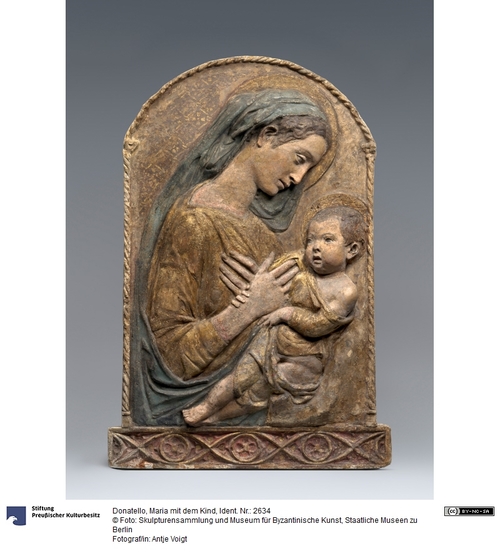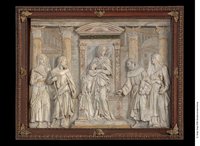After Donatello
2nd half of the 15th century
Virgin and Child (sometimes called the Ferrara Madonna)
Painted stucco
97 x 66 cm
Berlin, Staatliche Museen, Skulpturensammlung, Inv. SKS 2634.
Bode-Museum, storage.
Provenance
Florence, Stefano Bardini (1901); Berlin, Skulpturensammlung/Altes Museum (1901-1904); Berlin, Skulpturensammlung/Kaiser-Friedrich-Museum (1904-1939); Berlin, storage (1939-1945); Soviet Union, secret storage (1945/46-1958); East Berlin, Skulpturensammlung/Bode-Museum (1958-1990); Berlin, Skulpturensammlung/Bode-Museum (1990-present).
Acquisition
Bought in 1901 from the Florentine dealer Stefano Bardini, for 5,350 Italian lire. Acquisition file n°4308/01 (Zentralarchiv der Staatlichen Museen zu Berlin).
Exhibition
Schätze der Weltkultur von der Sowjetunion gerettet, East Berlin, National-Galerie and Pergamonmuseum, 1958, cat. D 49.
Other versions
• Ferrara, Museo di Casa Romei. Painted stucco, 76.6 x 52.5 cm. Provenance: Palazzo dei Diamanti, Ferrara.
• Formerly Amsterdam, Art Market (1925). 77 x 53 cm. Provenance: Berlin, Adolf von Beckerath; his sale (Nachlass Adolf von Beckerath Berlin, sale cat. Berlin, Rudolph Lepke, 23-26 May 1916, Berlin, Rudolph Lepke, 1916, p. 11 lot 67 pl. 14, as Donatello); C. Castiglioni collection (his sale, Amsterdam, 1925, lot 91).
• Formerly Florence, Art Market (Paolo Paoletti). Painted stucco, 81.3 x 55.3 cm. Provenance: Stefano Bardini, Florence; Raoul Tolentino, Florence; his sale (Important and Rare Italian and French Works of Art, sale cat. New York, American Art Galleries, 22-26 April 1924, lot. 894: as by Donatello, 30 x 22 inches, “from the Stefano Bardini Collection, acquired in Florence many years ago”); San Simeon, Willam Randolph Hearst collection, until 1958; San Francisco, D. C. Ashley collection, until 1963; New York, Sotheby’s, 22 June 1989, lot 49.
Comment
This image of the Virgin and Child seems very serene at first: the mother is adoring her son with her joined arms on her breast. A second look shows that the relationship between the figures is far more dynamic: the Virgin is grasping the garment of the Child, while the latter grabs his mother’s wrist, in order to keep his equilibrium (the boy’s right pinky has been lost, but is visible in other versions). The Child’s seat has disappeared but its original shape is clearly understandable; Jesus’ right foot seems to be pushing on the lower edge of the frame. The colors add to the realistic effect of the representation, even if much of it has been repainted over the centuries (at least four layers of paint can be distinguished; Klaus Leukers, oral communication, August 2014).
The relationship to Donatello’s oeuvre has always been underlined. The head of the Virgin is especially similar to works by the artist and his circle, such as the Madonna with four Cherubs in Berlin (Inv. SKS 54) or the Altman Madonna in the Metropolitan Museum of Art, New York (Inv. 14.40.680), whereas the composition of the adoring Virgin and the sitting Christ recalls not only the Madonna della Seggiola in the Victoria and Albert Museum, London (see Inv. SKS 67), but also the Piot Madonna in the Musée du Louvre, Paris (Inv. RF 3967). The drapery and the dynamic attitude contribute to this Donatellesque mood.
The material of this work – painted stucco – has led art historians to think that this relief was not the original version by Donatello – the latter may have been in marble or terracotta (only Colasanti 1931 thought of a direct attribution to the master). Indeed, technical analyses indicate that the work was cast in a mold and not modeled (Klaus Leukers, oral communication, August 2014). Some weaknesses are especially visible in Christ’s feet and in the reworked hem of the Virgin’s cloak, indicating that the work may be seen as a very close derivation from a creation by Donatello.
Three other versions of this relief have been recorded, none bein
Entstehungsort stilistisch: Florenz
de

